Self-Monitoring Blood Glucose Market Size
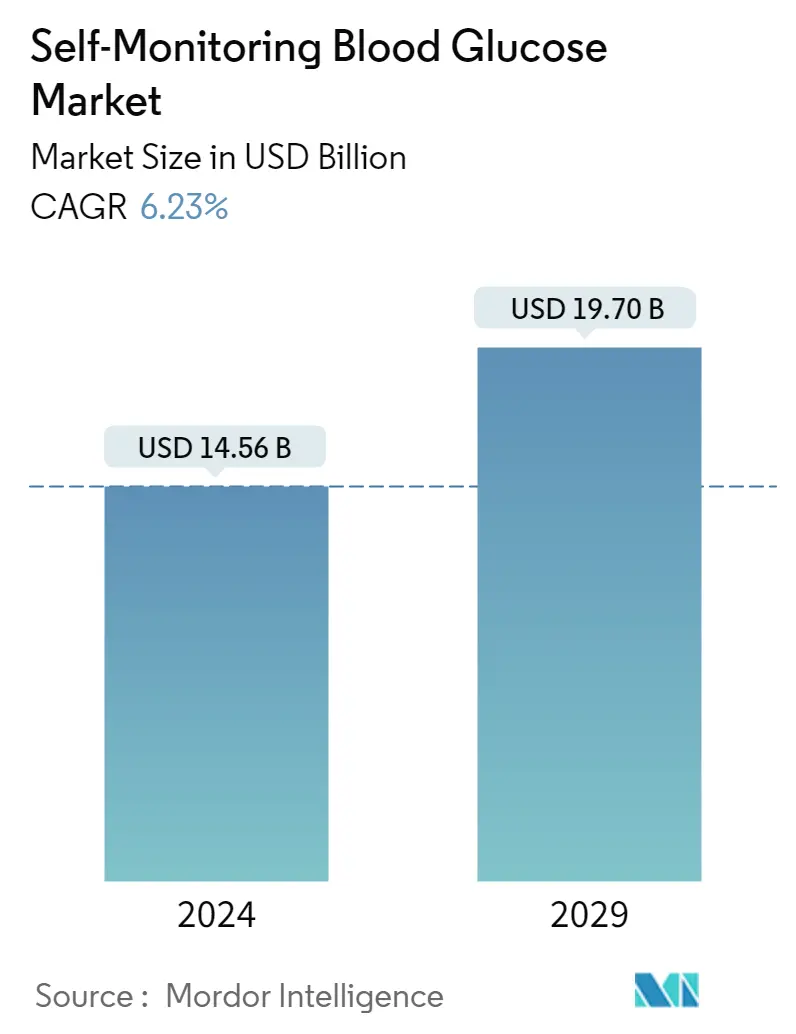
| Study Period | 2018 - 2029 |
| Market Size (2024) | USD 14.56 Billion |
| Market Size (2029) | USD 19.70 Billion |
| CAGR (2024 - 2029) | 6.23 % |
| Fastest Growing Market | North America |
| Largest Market | North America |
Major Players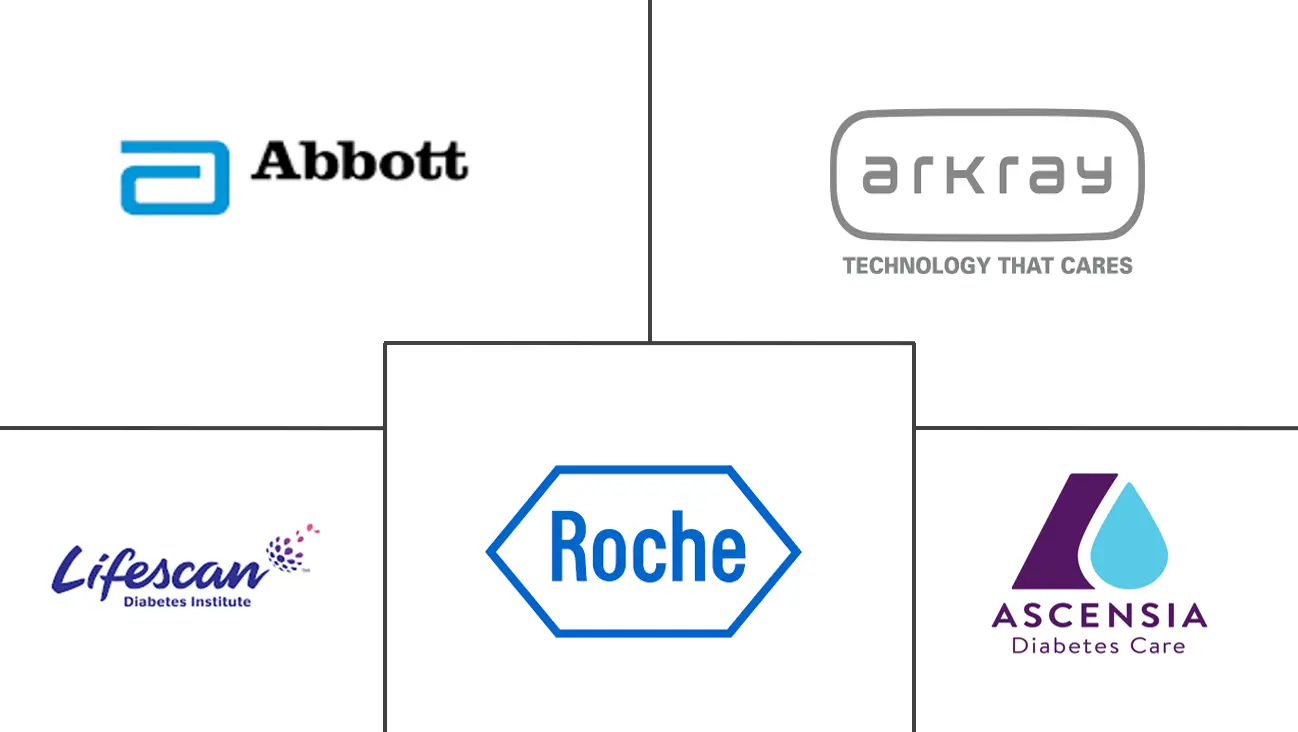
*Disclaimer: Major Players sorted in no particular order |
Self-Monitoring Blood Glucose Market Analysis
The Self-Monitoring Blood Glucose Market size is estimated at USD 14.56 billion in 2024, and is expected to reach USD 19.70 billion by 2029, growing at a CAGR of 6.23% during the forecast period (2024-2029).
During the COVID-19 pandemic, hyperglycemia, caused by both stress and diabetes mellitus, could be present in patients in the intensive care unit or non-ICU patients. The maintenance of euglycemia was essential to decrease both morbidity and mortality. According to experts, inpatient use of diabetes technology in patients with proper institutional protocols was safe and improved inpatient glycemic outcomes and played a vital role in managing hypoglycemia and hyperglycemia in hospitalized patients. According to the article published by the American Association of Clinical Endocrinology in December 2022, the inpatient standard of care for glucose monitoring consisted of capillary glucose measurement using glucometers. COVID-19 treatment involved high doses of corticosteroids with subsequent hyperglycemia and the need for higher insulin doses to control glucose. This dosing required more frequent glucose monitoring with glucometer checks.
According to the International Diabetes Federation (IDF), the adult diabetes population in 2021 is approximately 537 million, and this number is going to increase by 643 million in 2030. The main diagnosis for diabetes patients is imbalances in blood glucose levels, which do not comply with the standard blood glucose levels. General lab diagnostic tests can only help physicians diagnose the disease. Patients with more fluctuations in glucose levels need to get it checked daily. Patients administering insulin need to check their blood glucose levels frequently, adjust their insulin doses, or change the medication if necessary.
Technological advancements in blood glucose meters, including cellular-connected devices that automatically upload SMBG data to secure cloud-based databases, allow for improved sharing and monitoring of SMBG data. Real-time monitoring of SMBG data presents opportunities to provide timely support to patients responding to abnormal SMBG recordings. Such diabetes remote monitoring programs can provide patients with poorly controlled diabetes additional support needed to improve critical outcomes, thereby enhancing the market prospects in the years to come.
Self-Monitoring Blood Glucose Market Trends
The Glucometer Devices Segment is Expected to Witness the Highest CAGR
The glucometer devices segment is expected to account for the highest CAGR of about 8.2% over the forecast period, owing to the increasing adoption of glucometers in home care settings, growing preference for home-based self-monitoring, and recent product launches of advanced glucometers.
Glucometers are simple, portable, convenient blood sugar monitoring devices for point-of-care management. A drop of blood from the finger of the patient is dropped onto a paper test strip, which is impregnated with a glucose-specific enzyme that reacts with the glucose in the blood. The strip is inserted into the blood glucose meter and is read using either reflectance photometry or electrochemical technology to determine the glucose level in the blood. These monitors are also used to monitor blood glucose levels in clinical settings. In general, portable glucose devices have improved in precision and accuracy with each generation.
The self-monitoring blood glucose devices are garnering widespread adoption due to the availability of reimbursement options for glucose meters. Glucose meter devices must be replaced within six to eight months and are expensive. As a result, most people prefer health insurance plans that cover most of their total expenditure on healthcare devices. Such schemes cover the costs of diabetes testing supplies, test strips, and blood glucose meters. For example, Medicare, the federal health insurance program in the United States, covers approximately 80% of the cost of BGM devices for diabetic people.
The market players are adopting various strategies such as collaborations, partnerships, mergers, acquisitions, and expansions to increase market share. For instance, in May 2021, Roche Diabetes Care Canada announced a collaboration with Ellerca Health, a Toronto-based company dedicated to improving patient care through innovation and technology. The partnership will include the launch of Accu-Chek and 360Care, combining Roche's Accu-Chek Guide blood glucose meter, customized home delivery of testing strips, and Ellerca's self-management digital program, 360Care, which empowers patients to be in control of their treatment schedule with access to a team of health coaches.
Thus, the above-mentioned factors are expected to drive the segment growth over the forecast period.
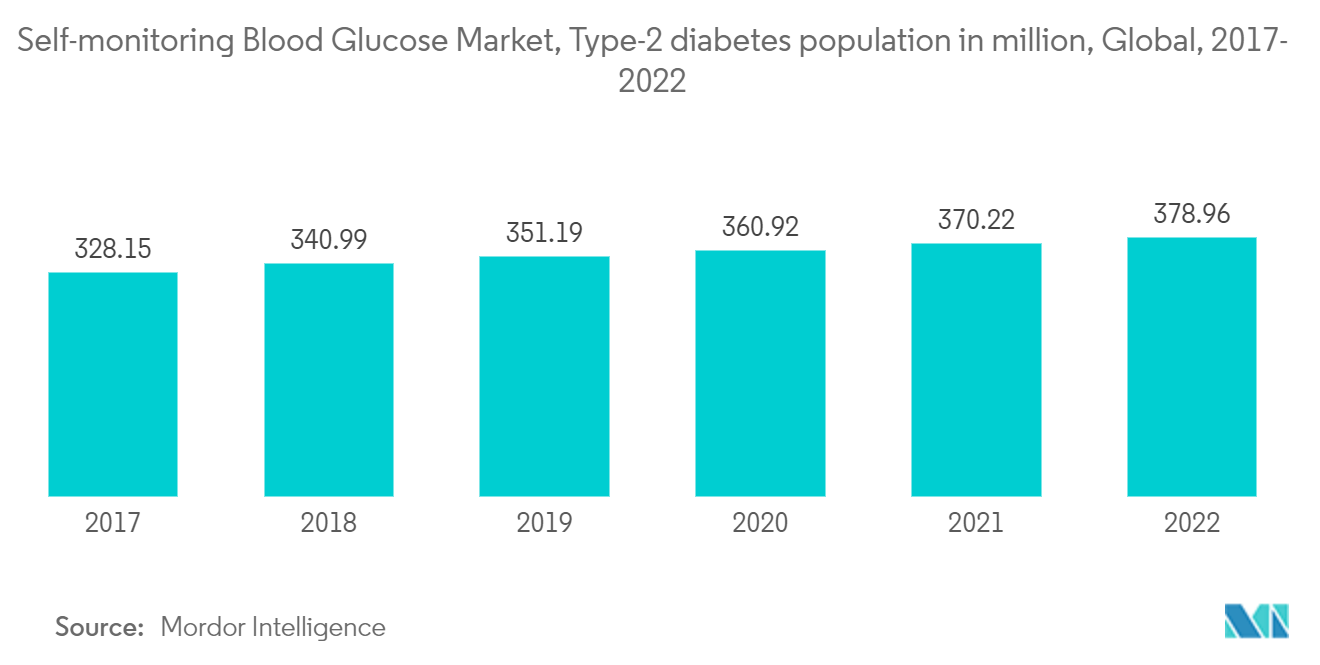
North America Holds the Highest Market Share in the Current Year
The North American region holds a market share of about 54% in the current year.
The prevalence of diabetes in the region has increased dramatically during the last two decades, a fact driven by the increased prevalence of obesity and lifestyle changes owing to less physical activity, unhealthy food habits, and other lifestyle factors.
The American Diabetes Association (ADA), the Endocrine Society, the American College of Physicians, the American Academy of Paediatrics, the Society of General Internal Medicine, and the National Academy of Medicine published statements and issued calls to action to address social determinants of health at the individual, organizational, and policy levels. In 2021, the ADA also published a scientific review describing the associations between SDOH and diabetes risk and outcomes, focusing on socioeconomic status, health literacy, the food environment, food insecurity, and neighborhood and physical environments, among other topics.
The Centers for Disease Control and Prevention (CDC) National Diabetes Statistics Report 2022 estimated that more than 130 million adults are living with diabetes or prediabetes in the United States. Type 2 diabetes is more common, and diabetes is more consequential among communities of color, those who live in rural areas, and those with less education, lower incomes, and lower health literacy.
Blood glucose devices are garnering widespread adoption due to the availability of reimbursement options for glucose meters. Glucose meter devices must be replaced within six to eight months. As a result, most people prefer health insurance plans that cover most of their total expenditure on healthcare devices. Various schemes cover the costs of diabetes testing supplies, test strips, and blood glucose meters. For example, Medicare, the federal health insurance program in the United States, covers approximately 80% of the cost of BGM devices for diabetic people.
In the United States, there are several innovations in diabetes management platforms by startups, like Glooko, OneDrop, Verily, Vacate, Insulet, Noom, Bigfoot Biomedical, Virta Health, and Diabeloop, and Orgenesis launched in the market. The growing awareness among people regarding advanced diabetes devices is improving the adaptability of PoCT glucose testing devices. Leading manufacturers focus on technological innovations and develop cutting-edge products to gain a substantial market share.
Therefore, the studied market is anticipated to grow over the analysis period due to rising prevalence and the aforementioned factors.
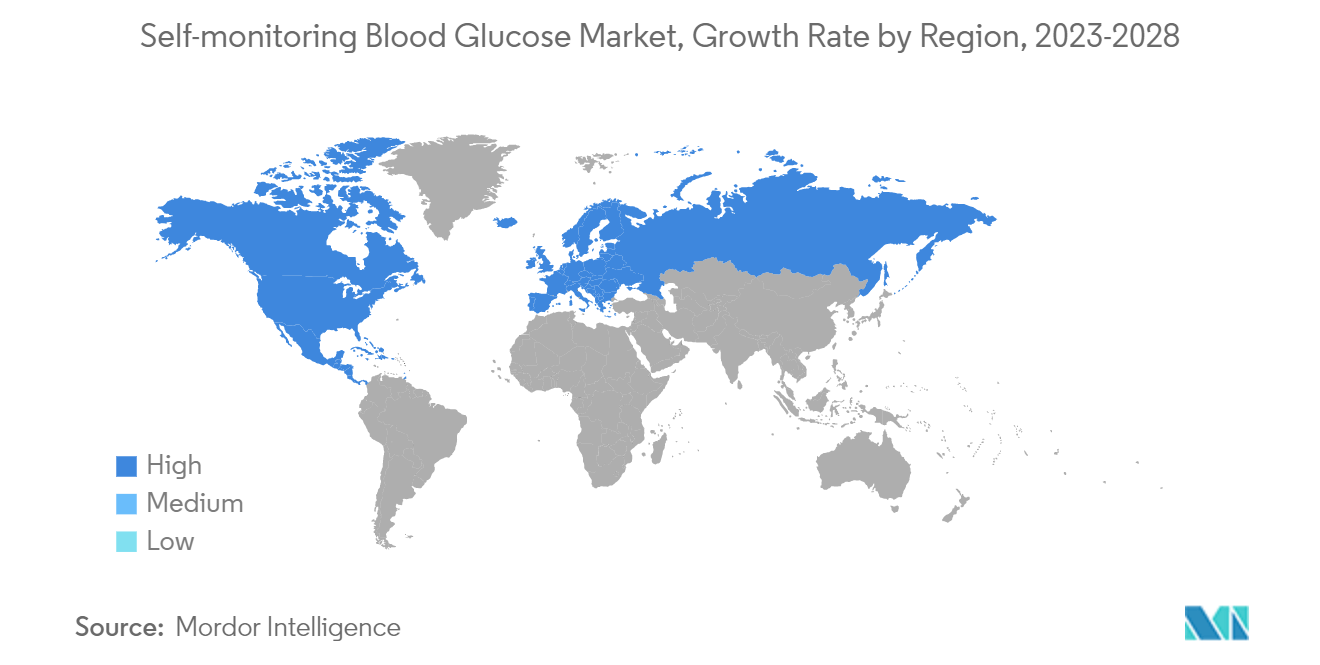
Self-Monitoring Blood Glucose Industry Overview
The self-monitoring blood glucose market is consolidated, with a few major manufacturers having a global market presence and occupying a major share, such as Abbott, LifeScan, F. Hoffmann-La Roche AG, and Ascensia, while the remaining confined to the other local or region-specific manufacturers.
Self-Monitoring Blood Glucose Market Leaders
-
F. Hoffmann-La Roche AG
-
Abbott Diabetes Care
-
Ascensia Diabetes Care
-
LifeScan Inc.
-
ARKRAY Inc.
*Disclaimer: Major Players sorted in no particular order
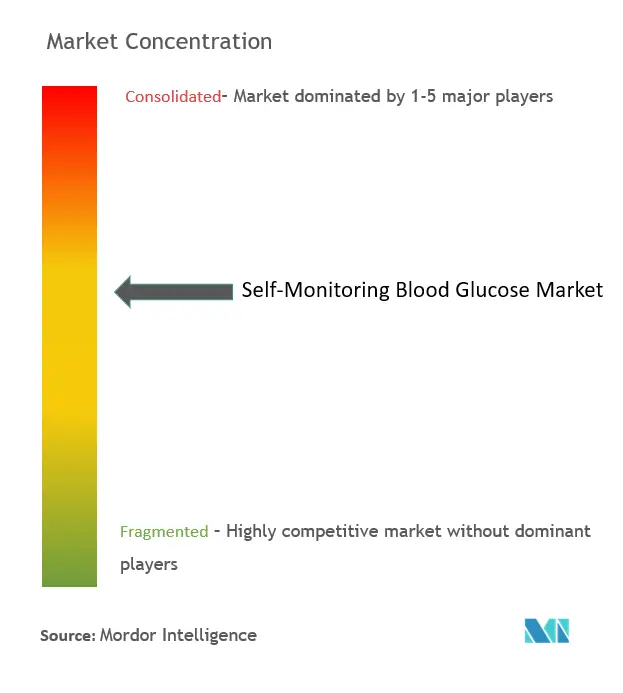
Self-Monitoring Blood Glucose Market News
- June 2022: LifeScan announced that the peer-reviewed journal Diabetes Technology and Therapeutics (DTT) published Real World Evidence of Improved Glycemic Control in People with Diabetes using a Bluetooth-connected Blood Glucose Meter with Mobile Diabetes Management Application using the OneTouch Reveal mobile app with the OneTouch Verio Reflect meter which can be synced via the Bluetooth wireless technology. It could support improved glycemic control for people with diabetes.
- January 2022: Roche launched its new point-of-care blood glucose monitor designed for hospital professionals, with a companion device shaped like a touchscreen smartphone that will run its apps. The hand-held Cobas pulse includes an automated glucose test strip reader, a camera, and a touchscreen for logging other diagnostic results. It’s designed for patients of all ages, including neonates and people in intensive care. The company said Cobas Pulse will start shipping to select European countries, carrying a CE mark, and it plans to seek clearances in the United States and other markets over the year.
Self-Monitoring Blood Glucose Market Report - Table of Contents
1. INTRODUCTION
- 1.1 Study Assumptions and Market Definition
- 1.2 Scope of the Study
2. RESEARCH METHODOLOGY
3. EXECUTIVE SUMMARY
4. MARKET DYNAMICS
- 4.1 Market Overview
- 4.2 Market Drivers
- 4.3 Market Restraints
-
4.4 Industry Attractiveness - Porter's Five Forces Analysis
- 4.4.1 Bargaining Power of Suppliers
- 4.4.2 Bargaining Power of Consumers
- 4.4.3 Threat of New Entrants
- 4.4.4 Threat of Substitute Products and Services
- 4.4.5 Intensity of Competitive Rivalry
5. MARKET SEGMENTATION
-
5.1 By Component
- 5.1.1 Glucometer Devices
- 5.1.2 Test Strips
- 5.1.3 Lancets
-
5.2 By End User
- 5.2.1 Hospital/Clinics
- 5.2.2 Personal/Home
-
5.3 By Geography
- 5.3.1 North America
- 5.3.1.1 United States
- 5.3.1.2 Canada
- 5.3.1.3 Rest of North America
- 5.3.2 Europe
- 5.3.2.1 France
- 5.3.2.2 Germany
- 5.3.2.3 Italy
- 5.3.2.4 Spain
- 5.3.2.5 United Kingdom
- 5.3.2.6 Russia
- 5.3.2.7 Rest of Europe
- 5.3.3 Latin America
- 5.3.3.1 Mexico
- 5.3.3.2 Brazil
- 5.3.3.3 Rest of Latin America
- 5.3.4 Asia-Pacific
- 5.3.4.1 Japan
- 5.3.4.2 South Korea
- 5.3.4.3 China
- 5.3.4.4 India
- 5.3.4.5 Australia
- 5.3.4.6 Vietnam
- 5.3.4.7 Malaysia
- 5.3.4.8 Indonesia
- 5.3.4.9 Philippines
- 5.3.4.10 Thailand
- 5.3.4.11 Rest of Asia-Pacific
- 5.3.5 Middle East & Africa
- 5.3.5.1 Saudi Arabia
- 5.3.5.2 Iran
- 5.3.5.3 Egypt
- 5.3.5.4 Oman
- 5.3.5.5 South Africa
- 5.3.5.6 Rest of Middle East & Africa
6. MARKET INDICATORS
- 6.1 Type-1 Diabetes Population
- 6.2 Type-2 Diabetes Population
7. COMPETITIVE LANDSCAPE
-
7.1 Company Profiles
- 7.1.1 Abbott
- 7.1.2 F. Hoffmann-La Roche AG
- 7.1.3 LifeScan
- 7.1.4 Arkray
- 7.1.5 Ascensia
- 7.1.6 Agamatrix Inc.
- 7.1.7 Bionime Corporation
- 7.1.8 Acon
- 7.1.9 Medisana
- 7.1.10 Trivida
- 7.1.11 Rossmax
- *List Not Exhaustive
-
7.2 COMPANY SHARE ANALYSIS
- 7.2.1 Abbott
- 7.2.2 Ascensia
- 7.2.3 F. Hoffmann-La Roche AG
- 7.2.4 Others
8. MARKET OPPORTUNITIES AND FUTURE TRENDS
** Subject To AvailablitySelf-Monitoring Blood Glucose Industry Segmentation
Self-monitoring blood glucose (SMBG) is an important aid in diabetes mellitus care. Patients with diabetes can measure their blood glucose to detect hypoglycemia, adjust the insulin doses as needed, and establish the response to nutrition and pharmacotherapy.
The Self-monitoring Blood Glucose Market is segmented into Components (Glucometer Devices, Test Strips, and Lancets) and Geography (North America, Europe, Asia-Pacific, Middle East & Africa, and Latin America). The report offers the value (in USD) and volume (in Units) for the above segments.
| By Component | Glucometer Devices | |
| Test Strips | ||
| Lancets | ||
| By End User | Hospital/Clinics | |
| Personal/Home | ||
| By Geography | North America | United States |
| Canada | ||
| Rest of North America | ||
| By Geography | Europe | France |
| Germany | ||
| Italy | ||
| Spain | ||
| United Kingdom | ||
| Russia | ||
| Rest of Europe | ||
| By Geography | Latin America | Mexico |
| Brazil | ||
| Rest of Latin America | ||
| By Geography | Asia-Pacific | Japan |
| South Korea | ||
| China | ||
| India | ||
| Australia | ||
| Vietnam | ||
| Malaysia | ||
| Indonesia | ||
| Philippines | ||
| Thailand | ||
| Rest of Asia-Pacific | ||
| By Geography | Middle East & Africa | Saudi Arabia |
| Iran | ||
| Egypt | ||
| Oman | ||
| South Africa | ||
| Rest of Middle East & Africa |
Self-Monitoring Blood Glucose Market Research FAQs
How big is the Self-Monitoring Blood Glucose Market?
The Self-Monitoring Blood Glucose Market size is expected to reach USD 14.56 billion in 2024 and grow at a CAGR of 6.23% to reach USD 19.70 billion by 2029.
What is the current Self-Monitoring Blood Glucose Market size?
In 2024, the Self-Monitoring Blood Glucose Market size is expected to reach USD 14.56 billion.
Who are the key players in Self-Monitoring Blood Glucose Market?
F. Hoffmann-La Roche AG, Abbott Diabetes Care, Ascensia Diabetes Care, LifeScan Inc. and ARKRAY Inc. are the major companies operating in the Self-Monitoring Blood Glucose Market.
Which is the fastest growing region in Self-Monitoring Blood Glucose Market?
North America is estimated to grow at the highest CAGR over the forecast period (2024-2029).
Which region has the biggest share in Self-Monitoring Blood Glucose Market?
In 2024, the North America accounts for the largest market share in Self-Monitoring Blood Glucose Market.
What years does this Self-Monitoring Blood Glucose Market cover, and what was the market size in 2023?
In 2023, the Self-Monitoring Blood Glucose Market size was estimated at USD 13.65 billion. The report covers the Self-Monitoring Blood Glucose Market historical market size for years: 2018, 2019, 2020, 2021, 2022 and 2023. The report also forecasts the Self-Monitoring Blood Glucose Market size for years: 2024, 2025, 2026, 2027, 2028 and 2029.
Self-Monitoring Blood Glucose Industry Report
Statistics for the 2024 Self-Monitoring Blood Glucose market share, size and revenue growth rate, created by Mordor Intelligence™ Industry Reports. Self-Monitoring Blood Glucose analysis includes a market forecast outlook to for 2024 to 2029 and historical overview. Get a sample of this industry analysis as a free report PDF download.



